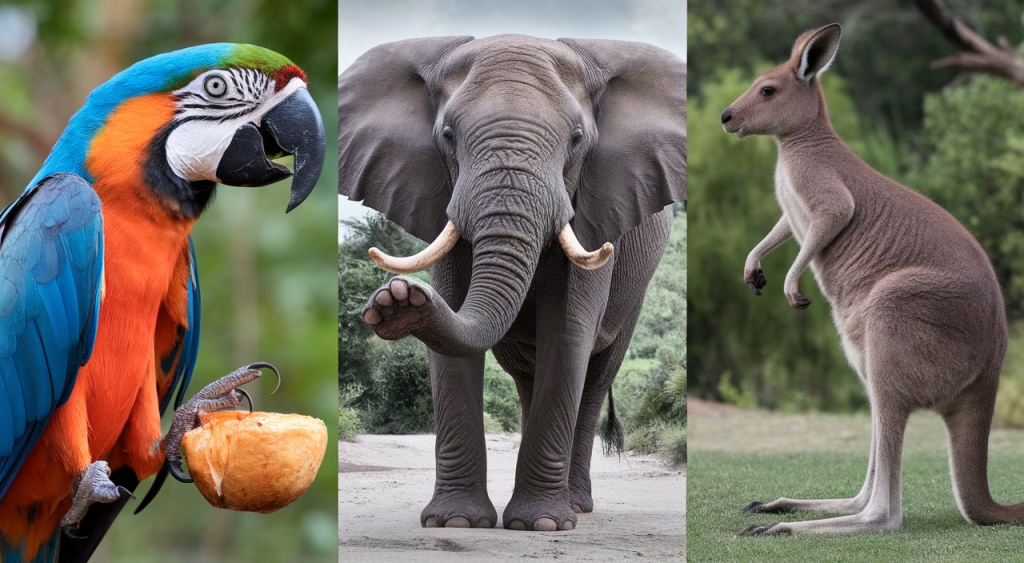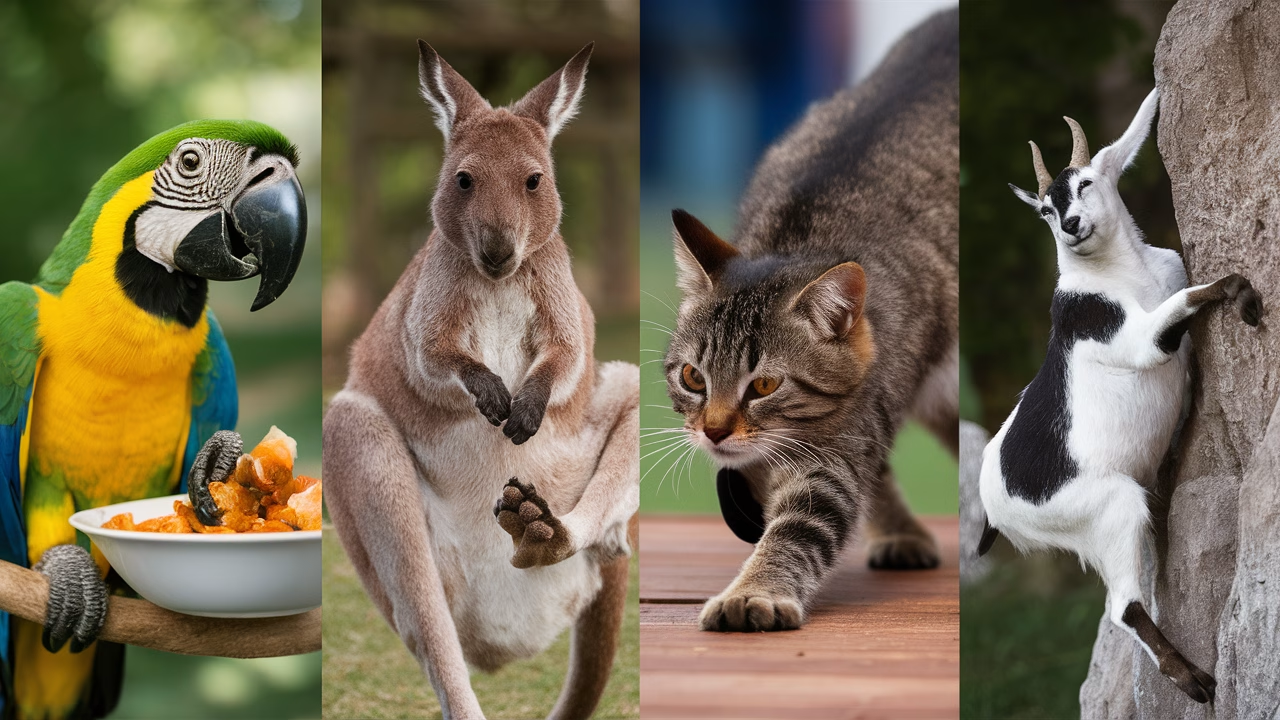What are some of the weirdest ways animals use their feet?
Nature offers no shortage of surprises when it comes to animal behavior—and their footwork is no exception. From martial arts moves to delicate grooming, animals use their feet in unexpected, downright bizarre ways. Let’s explore the creatures that prove feet are for more than just walking.
- Parrots use their zygodactyl toes like hands to grip and eat food.
- Tree frogs wave their feet to flirt and signal in noisy environments.
- Kangaroos use their powerful feet in kickboxing-style battles.
- Cats flex their ‘toe beans’ in stretches that serve biological functions.
- Secretary Birds stomp prey with shocking precision.
- Hamsters scoop and eat with their front paws like mini chefs.
- Goats scale cliffs with micro-movement precision via flexible hooves.
- Capybaras use webbed feet to glide and lounge in water.
- Rabbits thump warnings and dig with impressive vigor.
- Elephants communicate through vibrational foot sensitivity.
Check out this video for an entertaining overview:
The Quirky Feet of Parrots
Ever tried eating crackers with your toes? Parrots do it daily with their weird animal foot behaviors. With their zygodactyl feet—two toes facing forward and two backward—these birds boast a dexterity that rivals primates. Parrots routinely use their feet to grasp food, balance delicately on branches, and perform complex tasks like picking locks or manipulating toys. It’s no exaggeration to call them the ‘culinary experts’ of the avian world.
Why does this matter? Because that level of coordination wasn’t always associated with birds. Studies have shown that parrots can solve puzzle boxes using both beak and foot synergy, showcasing animal behavior that hints at higher cognition often underestimated in non-primates.
Tree Frog’s Fancy Footwork
When Sound Fails, Feet Speak
Some frogs croak, but Panamanian golden frogs dance—literally. These vibrant amphibians engage in ‘foot flagging,’ a semaphore-style display used to attract mates and deter rivals. Imagine a frog standing on a rock as a river roars nearby, silently waving his foot to grab a mate’s attention. It’s equal parts adorable and strategic among weird animal foot behaviors.
Interestingly, this animal behavior arose due to environmental noise. In loud habitats like rushing streams, vocal signals are drowned out. Evolution stepped in, gifting them a non-verbal backup. That’s interspecies sign language at its finest.
Kangaroo Kickboxing Moves
Fighting with Force and Precision
Think martial arts are a human invention? Tell that to a male kangaroo mid-fight. These marsupials balance on their tails and deliver two-legged kicks with the power to crumple opponents. Each kick is a biomechanical marvel, aimed specifically at soft tissue areas like the abdomen or sternum—one of nature’s most powerful weird animal foot behaviors.
Such displays aren’t always about injury. More often, they serve as dominance tests, showcasing power and genetic fitness. This animal behavior demonstrates incredible force—kangaroos don’t pull punches, they launch them with both feet.
Cat’s Toe Stretches and More
Toe Beans with a Purpose
Stretching might seem like a luxury, but for cats, it’s a necessity—and a spectacle. Known online for their ‘toe beans,’ cats splay their toes in luxurious stretches that increase circulation, activate buried tendons, and spread scent markers via foot glands. These weird animal foot behaviors serve multiple purposes beyond comfort.
This isn’t just cute. It’s also functional animal behavior. When a cat scratches a surface, those stretched paws leave behind scent trails—an invisible signature more complex than a social media profile. It’s how they claim space and communicate comfort.
Exploring Unique Animal Foot Adaptations
Comparative Behaviors Across the Animal Kingdom
| Animal | Foot Function | Habitat Influence | Behavioral Purpose |
|---|---|---|---|
| Secretary Bird | Precise stomping | Grasslands | Snake hunting |
| Hamster | Food handling | Domestic/captive | Feeding & grooming |
| Goat | Cliff climbing | Mountain terrains | Access to salt/minerals |
| Capybara | Webbed swimming | Wetlands | Mobility & thermoregulation |
| Rabbit | Stomping & digging | Grasslands/underground | Warning & nesting |
Whether used for danger alerts, social bonding, or catching dinner, these weird animal foot behaviors are anything but basic. Evolution has honed animal feet into custom tools for their environments—and animal behavior reflects that significance.
The Marvels of Elephant Communication
Feeling the World from the Ground Up
Despite their size, elephants exhibit one of the most subtle and remarkable weird animal foot behaviors—seismic communication. They can detect low-frequency ground vibrations known as infrasound through pads in their feet. This animal behavior lets them “hear” distant rumbles from other herds or potential threats from miles away.
So next time you see an elephant calmly stomping the earth or freezing mid-step, remember—it could be engaged in a long-distance foot-powered phone call through this fascinating animal behavior.
Conclusion: From Walkers to Multi-Tools
The phrase “put your best foot forward” takes on new meaning when exploring animals that use their feet in extraordinary ways. Whether fighting, flirting, feeding, or navigating cliffs, weird animal foot behaviors have evolved into multifunctional adaptations with remarkable precision and purpose.
Got a rabbit with a dramatic thump or a cat that stretches like a yogi? Share your foot-fueled animal stories with us. From quirky cuteness to serious survival, these animal behavior examples are tools worth studying—and celebrating.
Frequently Asked Questions
- Why do parrots use their feet to eat?
Parrots have zygodactyl feet that allow them to grasp food like hands. This foot-feeding behavior enhances dexterity and mimics primate-style eating. - What is foot flagging in frogs?
Foot flagging is a visual mating and territorial display used by tree frogs to communicate through movement when vocal calls are ineffective. - How strong is a kangaroo’s kick?
Kangaroo kicks are powerful enough to cause internal injuries in fights. They use their tail for balance, delivering two-legged kicks with extreme force. - What’s the purpose of a cat’s toe stretch?
It helps activate circulation, stretches tendons, and releases scents from glands, all while maintaining flexibility and balance. - How do elephants use feet to communicate?
Elephants detect ground-based vibrations through their feet, allowing them to sense long-distance messages through seismic infrasound. - How do mountain goats balance on cliffs?
They use split hooves with flexible pads and micro-adjustments to grip narrow surfaces, assisted by sensitive nerve endings in their feet. - Why do rabbits thump their feet?
Thumping is a rabbit’s way to signal danger, frustration, or disapproval—similar to a loud “hey, something’s wrong here!” alert.





